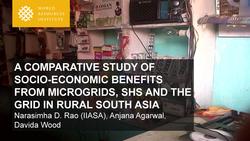A Comparative Study of Electricity Supply and Benefits from Microgirds, Solar Home Systems and the Grid in Rural South
From energypedia
Revision as of 08:55, 10 June 2015 by ***** (***** | *****)
The printable version is no longer supported and may have rendering errors. Please update your browser bookmarks and please use the default browser print function instead.
A Comparative Study of Electricity Supply and Benefits from Microgirds, Solar Home Systems and the Grid in Rural South
Presenter: Narasimha D.Rao, Anjana Agarwal and Davida Wood
Presentation
References
Narasimha D.Rao, Anjana Agarwal and Davida Wood: Micro Perspective for Decentralized Energy (MES) 2015, Bangalore, India.





















